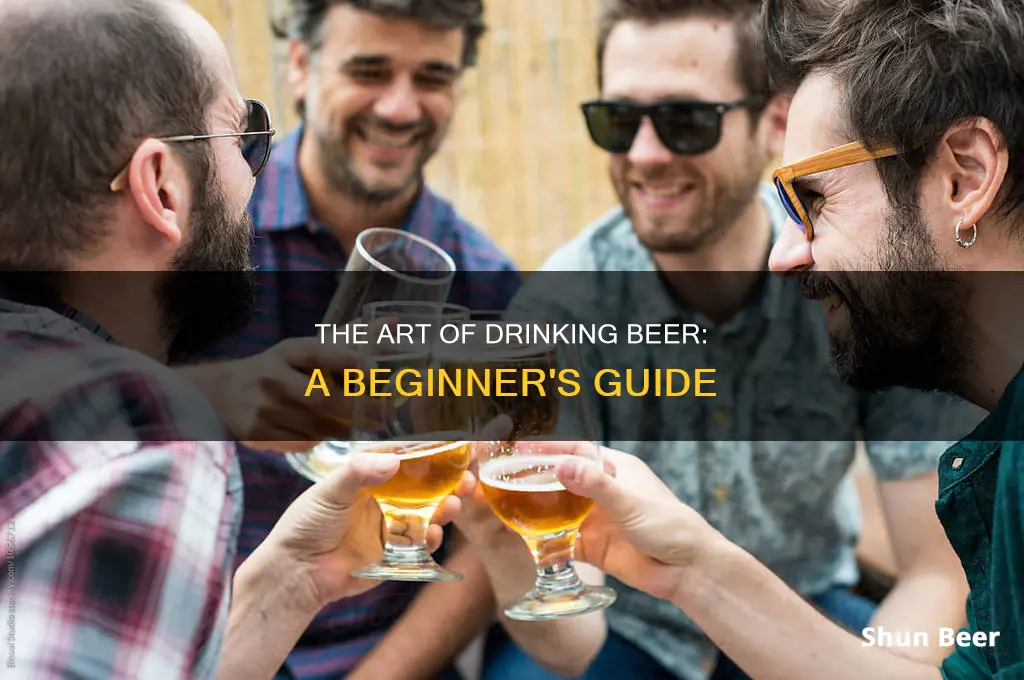
Drinking beer is a nuanced art. From the glass you choose to the speed at which you drink, there are many factors that can influence your experience.
First, you'll need to select your beer of choice. With hundreds of types of beer available, from fizzy and clear to dark and thick, you're sure to find something to suit your taste. If you're new to the beverage, you may want to start with lighter beers, like lagers or pilsners, instead of heavier beers, like stouts or IPAs, as they'll be less overpowering. You could also try craft beers, beers from other countries, or beers with added fruit.
Next, you'll need to consider the glassware. The glass you choose can affect the presentation, colour, aroma, and taste of your beer. A pint glass, for example, allows your hand to warm the beer and lets the aromas escape, whereas a wine glass can enhance the experience.
Now it's time to pour your beer. Start by tilting your glass to a 45-degree angle and pouring the beer down the side. Once the glass is half-full, level it out and finish pouring straight down the middle. This technique will help you achieve the perfect amount of head or foam.
Before you take your first sip, take a moment to appreciate the appearance of the beer. Notice the colour and the head. Then, give it a swirl and take a whiff to detect the aroma.
Finally, it's time to taste! Take a sip and let the beer sit on your palate. Breathe out through your nose and notice how the flavour changes. Repeat this process with each sip, savouring the nuances of the beer.
Remember, the speed at which you drink your beer is also a matter of preference. Some people prefer to sip their beer slowly, while others like to take bigger sips and finish their drink quickly. Ultimately, the proper way to drink beer is the way that you enjoy it most!
| Characteristics | Values |
|---|---|
| Beer type | Ale, lager, stout, bitter, wheat beer |
| Glass type | Mug, pint glass, goblet, pilsner glass, Weizen glass |
| Beer temperature | 50–60 °F (10–16 °C) for strong beers; 45–50 °F (7–10 °C) for lighter beers |
| Drinking speed | 5 minutes to 1 hour |
| Drinking technique | Sip, swig, gulp, chug |
What You'll Learn

Choosing the right glassware
Pint Glass
The pint glass is a staple in bars and a classic icon for beer enthusiasts. The American pint glass is a simple, tapered cylinder, wider at the opening and tapering down to a smaller base. It typically holds 16 ounces of liquid and is commonly used for a wide range of beers, including lagers, ales, IPAs, stouts, and porters. Its wide opening allows for head retention and the release of aromas.
The British or Imperial pint glass, also known as the "Nonic" or "Tumbler", is similar but holds 20 ounces and has a slight bulge or ridge towards the top, making it easier to stack and grip. This glass is commonly used for British ales and lagers.
Pilsner Glass
The Pilsner glass is tall, slim, and tapered, often resembling a trumpet. It showcases the sparkling colours, clarity, and carbonation of pilsners and other light beers. The wider top helps develop the aroma and flavour while maintaining the head. Pilsner glasses typically hold 10 to 16 ounces.
Tulip Glass
Also known as the Belgian glass, the Tulip glass has a round bowl with a flared lip, designed to promote the aroma and flavour of Belgian ales and other hoppy, malty beers. The short stem allows for swirling, enhancing the sensory experience. This glass is suitable for Belgian dark ale, Belgian strong ale, and American wild ale, among others.
Thistle Glass
The Thistle glass is a modified version of the Tulip glass, resembling Scotland's national flower, the thistle. It has a short stem, a round base, and a more elongated and angular top half than the Tulip glass. This glass is typically used for Scotch ale.
Goblet or Chalice
Goblets or Chalices are elegant and sophisticated glassware with a long, thick stem supporting a wide-mouthed bowl. They allow drinkers to hold the glass without warming the beer while enhancing its aromas. The wide mouth helps maintain the beer's head and allows for deep sips. Goblets are commonly used for German bocks, Belgian IPAs, Belgian ales, and other high-ABV beers.
Weizen Glass
The Weizen glass is tall and slender, showcasing the colour of wheat beers. It has thin walls that allow for proper headspace and lock in the signature wheat beer aroma. The narrow bottom and flared top help maintain carbonation and capture rich aromas. This glass is typically used for wheat ales, kristalweizens, and hefeweizens.
Stange Glass
The Stange glass, also known as the "champagne flute of beer glasses", is tall, narrow, and lightweight, with a thick bottom for sturdiness. It is perfect for showcasing delicate and nuanced beers, as its slender design highlights carbonation, aroma, and crispness. This glass is commonly used for Kolsch, Bocks, Lambics, and other similar beers.
IPA Glass
The IPA glass is designed with wave-like ridges on the bottom, which create more foam and push the hop aromatics upward. This glass is suitable for all varieties of IPAs.
Stout Glass
The Stout glass has a distinctive shape that helps enhance the notes of coffee, chocolate, and roasted malts commonly found in stouts. Its narrow mouth and angled neck aid in head retention.
Snifter
The Snifter, typically associated with brandy or cognac, is a short-stemmed glass with a wide bottom and narrow top. The wider base allows for aroma enhancement, and the round bottom makes it comfortable to hold in your hands. This glass is suitable for stronger, aromatic beers with higher alcohol content, such as Belgian ales, India Pale Ales, and wheat wines.
Beer and Cutting: Is It Possible to Enjoy Both?
You may want to see also

Pouring technique
The pouring technique is an important part of drinking beer. Here is a step-by-step guide to pouring the perfect beer:
Firstly, clean your beer glass with hot water. A dirty glass may contain oils or grime that can interfere with the true flavour of the beer and affect the head or foam. For a quick clean, simply rinse the glass with hot water. For a more thorough clean, mix 2 teaspoons of salt, 1/4 teaspoon of baking soda, and 4 teaspoons of water, then use this mixture to scrub the glass, rinsing it with hot water afterwards.
Next, tilt the glass to a 45-degree angle and begin pouring the beer down the side. Aim for about 1-1.5 inches of head or foam. When the glass is about halfway full, slowly level it out and finish pouring straight into the glass. This will minimise carbonation and reduce the amount of head created.
Some people prefer a "double pour" for heavier beers, such as Guinness. This involves pouring the beer halfway, waiting for the head to dissipate, and then finishing the pour.
If your beer is forming too much head, start pouring straight down the middle of the glass sooner. If it's not forming enough, keep it at an angle for longer.
Now your beer is poured and ready to be enjoyed! But remember, beer is best enjoyed fresh, so don't let it sit out and get warm and stale.
Breastfeeding and Beer: Is Half a Beer Safe?
You may want to see also

Drinking speed
When it comes to drinking beer, it's important to find a pace that suits the occasion and your own preferences. A slow and steady pace is generally recommended, especially when savouring a high-quality craft beer or when socialising with friends. This allows you to appreciate the complex flavours and aromas of the beer and prevents you from consuming too much, too quickly. Taking small sips and pausing between drinks can help you better taste the beer and control your intake.
However, there may be times when a faster drinking speed is preferred or even necessary. For example, when drinking a pint before it loses its ideal temperature or when trying to beat the clock during a fun drinking game with friends. In these cases, a faster pace can be enjoyable and add to the excitement of the moment. Just be mindful that drinking too quickly can lead to spills and overconsumption, potentially ruining the taste experience and leading to negative side effects.
The ideal drinking speed will also depend on the type of beer you're enjoying. For example, a strong, high-ABV beer or an intensely flavoured imperial stout is usually sipped slowly and appreciated in small quantities. These beers are often savoured like a fine wine or a premium spirit, with time taken to appreciate their complex flavours and aromas. On the other hand, a light, refreshing pilsner or a crisp, easy-drinking lager can be enjoyed at a slightly faster pace, especially during hot weather or when you're looking for quick hydration alongside a satisfying hit of flavour.
Personal preference also plays a significant role in drinking speed. Some people prefer to take their time with any beer, regardless of style, to fully appreciate the nuances of each brew. Others may have a higher tolerance or a preference for faster consumption, particularly when drinking with friends and creating a lively atmosphere. Ultimately, the ideal drinking speed is the one that allows you to enjoy your beer to the fullest, whether that means savouring every sip or joining in on a lively drinking session with companions.
Light Beer, Meth: A Dangerous Cocktail?
You may want to see also

Pairing with food
When it comes to pairing beer with food, there are a few things to keep in mind. Firstly, there are no hard and fast rules, as different beers can taste different to different people. However, here are some general guidelines and popular pairings to help you get the most out of your beer-drinking experience:
Contrast
Create an ideal pairing by choosing a beer or dish with one strong, dominant flavour, such as sweet, rich, or oily. This allows the distinct taste of the dish to shine through without being overpowered by the beer. A classic example of a good contrast pairing is oysters and stout. The briny flavour of oysters can stand up to the rich texture and chocolate notes of the stout. Another example is fatty seafood dishes paired with a hoppy IPA – the bitterness of the beer cuts through the fat of the dish.
Complement
One of the simplest ways to pair beer with food is to complement the flavours. Match rich foods with heavy and rich beers like stouts or porters. Pair light-tasting salads, fish, and fruit desserts with light beers. Wheat beers go well with Indian food, fruit desserts, and Buffalo wings, bringing out their citrusy notes. Amber ales complement grilled meats, sausages, burgers, and grilled seafood, bringing out the caramel notes of the beer. Dark beers, such as stouts and porters, pair well with rich, chocolatey desserts, as well as flavourful Mexican food and shellfish.
Cleanse
Beer can also serve as a palate cleanser, especially with dishes that have bold or intense flavours, such as spicy foods or rich fried foods. A light, crisp beer can help wash down the heat of a spicy dish, while a fatty food like French fries can balance out the bitterness of an IPA.
Avoid Overpowering Flavours
Be mindful of the levels of flavour in your food and beer. Medium and dark beers, such as stouts and porters, have rich and powerful flavours that can overpower certain types of food. For example, pairing a strong-flavoured beer like Guinness with a delicate fish like salmon would result in the beer overwhelming the taste of the fish.
Beer Styles and Pairings
The different styles of beer also offer varied pairing options:
- IPAs (India Pale Ales) – IPAs pair well with a range of dishes, including Thai curry, Mexican food, oily fish like salmon, steak, burgers, and roasted quail.
- Wheat Beers – These light and versatile beers go well with Indian food, fruit desserts, Buffalo wings, and spicy Thai noodle dishes.
- Stouts – Stouts are perfect for rich, chocolatey desserts, flavourful Mexican food, and shellfish, especially oysters.
- Porters – Porters, with their toasty and chocolatey flavours, pair well with BBQ ribs, steak and stilton pie, venison or beef stew, and dark chocolate desserts.
- Pale Lagers – Pale lagers are versatile and can be paired with both rich and light dishes. They go well with simple salads, spicy foods, herby chicken dishes, brie, and olives.
- Amber Ales – Amber ales complement rich and creamy risotto, pepperoni pizza, grilled meats, and grilled seafood, as well as tomato-based dishes like moussaka and spaghetti bolognese.
Drinking 10 Beers Daily: A Recipe for Disaster
You may want to see also

Serving temperature
The serving temperature of a beer can make a big difference to its taste. In general, beers with a higher alcohol percentage require higher storing temperatures. Dark ales, barley wines, or tripels should be stored at 50 to 60 °F (10 to 16 °C). Lighter beers, such as lagers, blondes, and pilsners, should be served at around 33 to 45 °F (1 to 7 °C).
Standard ales (e.g. bitters, IPAs, doppelbocks, lambics, stouts) should be served at "cellar temperature," which is 50 to 55 °F (10 to 13 °C).
Strong beers (e.g. barley wines, tripels, and dark ales) are best enjoyed just below room temperature, at around 50 to 60 °F (10 to 16 °C).
It's important to note that the serving temperature of beer can affect not only its taste but also its lifespan. Storing beer at temperatures higher than 60 °F (16 °C) will shorten its lifespan, while temperatures lower than 45 °F (7 °C) will make it hazy or cloudy.
Additionally, drinking beer straight from a frosted mug is not recommended as it can cause the beer to freeze where it touches the glass, spoiling the flavor.
When it comes to drinking beer, it's also worth considering the type of glassware used. The shape of the glass can affect the beer's presentation, color, aroma, and taste. For instance, a pint glass allows your hands to warm the beer and lets the aromas escape, while a wine glass might be a better alternative for enhancing each sip.
Drinking Beer by the Pool: Is it Allowed?
You may want to see also
Frequently asked questions
The best way to drink a beer is by pouring it into a glass at a 45-degree angle. This will create the perfect amount of "head" or foam.
The type of glass you use depends on the type of beer you are drinking. For example, a mug is good for IPAs, and a pint glass is good for American ales.
The best temperature to drink a beer is slightly warmer than ice-cold. As the beer warms up, its aromas are released, and its flavours become easier to detect.
Unlike wine, it is not recommended to swirl a beer. Swirling a beer will release its aroma but will also cause it to lose carbonation and its head.
This depends on the person drinking the beer, the type of beer, and the situation. On average, it takes about 5-20 minutes to finish a beer.







